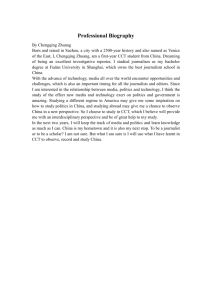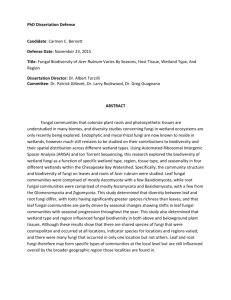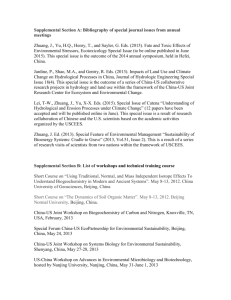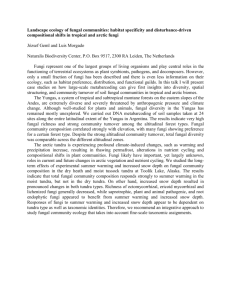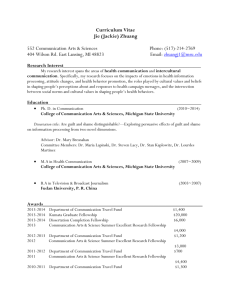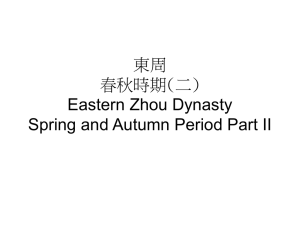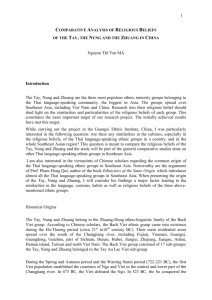ZHUANG Wenying
advertisement
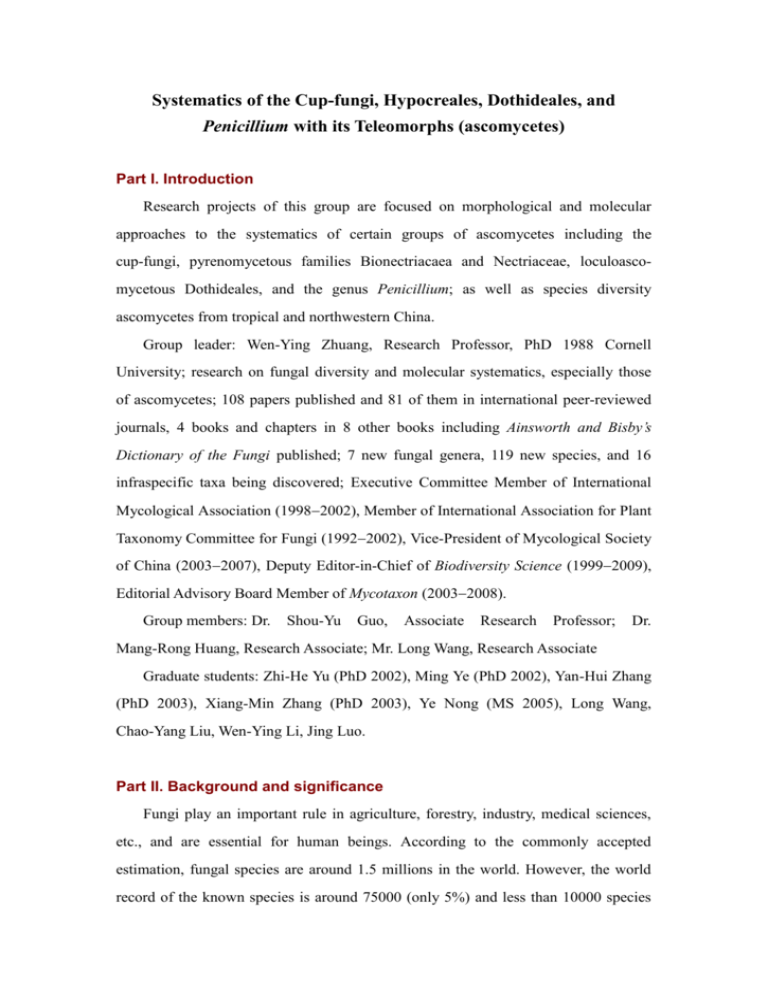
Systematics of the Cup-fungi, Hypocreales, Dothideales, and Penicillium with its Teleomorphs (ascomycetes) Part I. Introduction Research projects of this group are focused on morphological and molecular approaches to the systematics of certain groups of ascomycetes including the cup-fungi, pyrenomycetous families Bionectriacaea and Nectriaceae, loculoascomycetous Dothideales, and the genus Penicillium; as well as species diversity ascomycetes from tropical and northwestern China. Group leader: Wen-Ying Zhuang, Research Professor, PhD 1988 Cornell University; research on fungal diversity and molecular systematics, especially those of ascomycetes; 108 papers published and 81 of them in international peer-reviewed journals, 4 books and chapters in 8 other books including Ainsworth and Bisby’s Dictionary of the Fungi published; 7 new fungal genera, 119 new species, and 16 infraspecific taxa being discovered; Executive Committee Member of International Mycological Association (19982002), Member of International Association for Plant Taxonomy Committee for Fungi (19922002), Vice-President of Mycological Society of China (20032007), Deputy Editor-in-Chief of Biodiversity Science (19992009), Editorial Advisory Board Member of Mycotaxon (20032008). Group members: Dr. Shou-Yu Guo, Associate Research Professor; Dr. Mang-Rong Huang, Research Associate; Mr. Long Wang, Research Associate Graduate students: Zhi-He Yu (PhD 2002), Ming Ye (PhD 2002), Yan-Hui Zhang (PhD 2003), Xiang-Min Zhang (PhD 2003), Ye Nong (MS 2005), Long Wang, Chao-Yang Liu, Wen-Ying Li, Jing Luo. Part II. Background and significance Fungi play an important rule in agriculture, forestry, industry, medical sciences, etc., and are essential for human beings. According to the commonly accepted estimation, fungal species are around 1.5 millions in the world. However, the world record of the known species is around 75000 (only 5%) and less than 10000 species have been reported from China. To discover the unknown, to give better understanding of fungal diversity as well as fungal evolution, and to make a sufficient use of fungi, studies on fungal taxonomy, and evolution are urgent tasks. Our research team has been working on different groups of fungi for 30 years and is distinctive on ascomycete studies. Part III. Major achievements Projects conducted and progress made: 1) Research on the Chinese Fungus Flora. In the past 5 years, more than 2100 ascomycete specimens were collected; taxonomic work has been done based on the herbarium and newly collected materials. Flora Fungorum Sinicorum Vol. 21. Hyaloscyphaceae, Sarcoscyphaceae, Sarcosomataceae was published in 2004, in which 141 species and 5 varieties belonging to 34 genera in the three families were recorded with detailed descriptions, illustrations and discussions, among them 37 new species and 4 new varieties were published based on the Chinese material. Work on “Flora Fungorum Sinicorum Vol. ??. Pyronemataceae” is in progress. 2) Species diversity and molecular systematics of the genus Hymenoscyphus. Preliminary approaches to the phylogeny of Hymenoscyphus and their allies based on nrDNA ITS1-5.8S-ITS2 sequence analyses were performed. The results indicated that the current Hymenoscyphus is not monophyletic. As a segregate, a new genus Rhizoscyphus was proposed to accommodate species closely associated with plant roots and mycorrhizal. 3) Taxonomy and molecular systematics of the Bionectriaceae and Nectriaceae. Biodiversity of the Bionectriaceae and Nectriaceae from China was studied following modern taxonomic treatments. Seventy-three species have been found in tropical and central China, which doubles the previous Chinese record of the groups. Five papers were published, in which 6 new species, 5 new combinations, and 21 new Chinese records were found. One paper on phylogeny of the Nectriaceae based on sequence analyses of the nrDNA 28S D1/D2 region was completed. 4) Phylogeny of the genus Penicillium. Phylogenetic approach to the genus Penicillium based on sequence analyses of the calmodulin gene was undertaken. Seventy-six isolates of 56 taxa of penicillia were involved. The nucleotide sequences with and without introns were analyzed respectively using the neighbor-joining (NJ) and most parsimony (MP) methods. The cluster analysis on relative synonymous codon usage (RSCU) of each sequence was carried out. The fact that species of penicillia belong to the two subfamilies of the Trichocomaceae proposed by Malloch based on traditional methods is supported by our molecular data, whereas, the development of asci and patterns of penicilli show little phylogenetic information. 5) Species diversity of higher fungi from tropical China (collaborated research). The vast areas of China are located in the temperate zone and her tropical land is very limited. Fungi in tropical China were previously understudied and many natural reserves in the tropics had never been explored. In this project, higher fungi were selected as the subject. In order to draw a clear picture of fungal diversity in tropical China, to solve the taxonomic or systematic problems in certain groups of fungi, to protect and conserve the useful fungal resources, and to improve the efficiency of mycological research, field investigations in the tropics, morphological, anatomical and molecular techniques, and fungal database designing were integrated to perform the project. Scientists in the research team re-examined a large number of fungal specimens on deposit in different mycological herbaria of the country, collected 5800 fresh materials from more than 30 natural reserves, managed to obtain pure cultures, identified the new collections, and revealed the relationships among some groups of ascomycetes. The book Higher Fungi of Tropical China was published in 2001, in which 5056 species belonging to 1192 genera were recorded from the limited tropical areas of the country, which updates the figure of the known fungi from China; in which edible, medicinal, symbiotic and endophytic fungi are listed; in which the modern taxonomic systems are applied; and in which the latest references related to taxa involved are provided and detailed tropical distribution and inhabitation of each species are shown. 34 research papers were published. Two databases were established, the first “Multimedia database of higher fungi from tropical China” and “Specimen database of fungi from tropical China” in which information about 9247 specimens of 2747 species occurring in 88 tropical counties from 5 provinces is provided, which benefits mycologists domestic and abroad and makes research work much more efficient. 6) Species diversity of fungi from northwestern China (collaborated research). Field trips to different nature reserves of Xinjiang and Qinghai provinces were organized. More than 4700 fungal specimens and 200 soil samples were collected from the northwestern China. Species diversity of fungi in the region was investigated. The book Fungi of Northwestern China was published in 2005 based on the authors’ own investigations and taxonomic studies, as well as records appeared in the literature. 3887 taxa belonging to 759 genera of fungi known from Gansu, Ningxia, Qinghai, Shaanxi and Xinjiang, China were included in the book. Useful references, detailed distribution, hosts or substrates, and specimen information for each species are provided, which are valuable to scientists and students in mycology and the related fields. Two databases were established, “Economic fungi of northwestern China” and “Fungal specimen database of northwestern China ”. Papers published in 2001—2005: 1. Zhuang, W.-y. & K. D. Hyde (2001a) Discomycetes of tropical China. V. Species new to Hong Kong. Fungal Diversity 6: 181-188. 2. Zhuang, W.-y. & K. D. Hyde (2001b) New species of Lachnum and Perrotia from Hong Kong, China. Mycologia 93: 606-611. 3. Zhuang, W.-y. & Z.-h. Yu (2001) Two new species of Perrotia (Helotiales, Hyaloscyphaceae) from tropical China and a key to the known species of the genus. Nova Hedwigia 73: 261-267. 4. Zhuang, W.-y. (2001) A list of discomycetes in China. Supplement I. Mycotaxon 79: 375-381. 5. Zhuang, W.-y., Z.-h. Yu, Y.-h. Zhang, & M. Ye (2002) Some new species and new records of discomycetes in China. IX. Mycotaxon 81: 27-34. 6. Zhang, Y.-h. & W.-y. Zhuang* (2002) Re-examinations of Helotium and Hymenoscyphus (Helotiales, Helotiaceae): Specimens on deposit in HMAS. Mycotaxon 81: 35-43. 7. Ye, M. & W.-y. Zhuang* (2002) New records of Lachnum from temperate China. Mycosystema 21: 122-124. 8. Zhuang, W.-y. & X.-m. Zhang (2002) Re-examinations of Bionectriaceae and Nectriaceae (Hypocreales) from tropical China on deposit in HMAS. Nova Hedwigia 74(1-2): 275-283. 9. Yu, Z.-h. & W.-y. Zhuang* (2002) New taxa and new records of Lachnum and Arachnopeziza (Helotiales, Hyaloscyphaceae) form tropical China. Nova Hedwigia 74(3-4): 415-428. 10. Ye, M. & W.-y. Zhuang* (2002) Preliminary study on phylogenetic relationships in the genus Lachnum inferred from sequences of ITS regions and 5.8S ribosomal DNA. Mycosystema 21(3): 340-345. (in Chinese). 11. Zhuang, W.-y. (2002) Some new species and new records of discomycetes in China. X. Mycosystema 21: 475-479. 12. Zhang, Y.-h. & W.-y. Zhuang* (2002) New species and new Chinese records of Hymenoscyphus (Helotiales). Mycosystema 21: 493-496. 13. Guo, S.-X., Q.-Y. Wang, W.-Y. Zhuang, J.-H. Zhang & X.-K. Xing (2002) Discovery and application of the companion fungus related to sclerotial formation from hyphae of Grifola umbellata. Acta Bot. Sin. 44: 1151-1154. 14. Zhuang, W.-y. & Y.-h. Zhang (2002) Designation of an epitype for Helotium yunnanense and its transfer to the genus Lambertella (Rutstroemiaceae, Ascomycota). Taxon 51: 769-770. 15. Zhang, X.-m. & W.-y. Zhuang* (2003a) Re-examinations of Bionectriaceae and Nectriaceae (Hypocreales) from temperate China on deposit in HMAS. Nova Hedwigia 76: 191-200. 16. Yu, Z.-h. & W.-y. Zhuang* (2003a) Phylogenetic relationships of Lachnum and related genera inferred from partial sequences of 18S rDNA. Mycosystema 22: 42-49. (in Chinese). 17. Yu, Z.-h. & W.-y. Zhuang* (2003b) Species diversity of Lachnum (Hyaloscyphaceae, Ascomycotina) from tropical China. Biodiv. Sci. 11: 141-146. (in Chinese). 18. Ye, M. & W.-y. Zhuang* (2003) New taxa of Lachnum (Helotiales, Hyaloscyphaceae) from temperate China. Nova Hedwigia 76: 443-450. 19. Zhuang, W.-y. (2003a) A list of discomycetes in China. Supplement II. Mycotaxon 85: 153-157. 20. Zhuang, W.-y. (2003b) Re-dispositions of Phillipsia (Pezizales) collections from China. Mycotaxon 86: 291-301. 21. Zhuang, W.-y. (2003c) A new species of Lachnum on leaves of Livistona and a key to the Chinese species of the genus. Mycotaxon 86: 375-382. 22. Zhuang, W.-y. (2003d) Notes on Wynnea (Pezizales) from Asia. Mycotaxon 87: 131-136. 23. Zhuang, W.-Y. (2003e) Some new species and new records of discomycetes in China. XI. Mycotaxon 87: 467-473. 24. Zhang, X.-m. & W.-y. Zhuang* (2003b) New species and new records of the Bionectriaceae and Nectriaceae (Hypocreales) from China. Mycotaxon 88: 343-347. 25. Zhang, X.-m. & W.-y. Zhuang* (2003c) New Chinese records of the Bionectriaceae and Nectriaceae (Hypocreales). Mycosystema 22: 515-521. (in Chinese). 26. Liu, B., X.-z. Liu* & W.-y. Zhuang (2003) The Orbiliaceae and its anamorphs. Mycosystema 22: 670-677. (in Chinese). 27. Zhuang, W.-y. (2004a) New taxa of Lachnum (Ascomycetes, Helotiales) on bamboo and a key to the bambusicolous species of the genus. Nova Hedwigia 78: 425-433. 28. Zhang, Y.-h. & W.-y. Zhuang* (2004) Phylogenetic relationships of some members in the genus Hymenoscyphus (Ascomycetes, Helotiales). Nova Hedwigia 78: 475-484. 29. Zhuang, W.-y. (2004b) Notes on Humarina xylariicola. Mycosystema 23: 434-436. 30. Zhuang, W.-y. (2004c) Preliminary survey of the Helvellaceae from Xinjiang, China. Mycotaxon 90: 35-42. 31. Zhuang W.-y. (2004d) Additional notes on Wynnea from Asia. Nova Hedwigia 79: 519-526. 32. Wang, L. & W.-y. Zhuang* (2004) Designing primer sets for amplification of partial calmodulin genes from penicillia. Mycosystema 23: 466-473. 33. Zhuang W.-y. (2005a) Re-dispositions of specimens filed under Lachnea on deposit in HMAS. Fungal Diversity 18: 211-224. 34. Liu, B., X.-z. Liu* & W.-y. Zhuang (2005) Orbilia querci sp. nov. and its knob-forming nematophagous anamorph. FEMS Microbiology Letters 245: 99-105. 35. Nong, Y. & W.-y. Zhuang* (2005) Preliminary survey of Bionectriaceae and Nectriaceae (Hypocreales) from Jigongshan, China. Fungal Diversity 19: 95-107. 36. Zhuang, W.-y. (2005b) Some new species and new records of discomycetes from China. XII. Mycotaxon 93: (accepted) [* Author for correspondence.] Books and chapters published in 2001—2005 1. Zhuang, W.-Y. (ed.) (2001) Higher Fungi of Tropical China. Mycotaxon Ltd. Ithaca. pp. 1-485. 2. Zhuang, W.-Y. (2001) Genera of the Helotiales, Leotiales, and Pezizales [with nearly 1000 generic names]. In Kirk, P.M., P.F. Cannon, J.C. David & J.A. Stalpers (eds.) Ainsworth & Bisby’s Dictionary of the Fungi (ed. 9). CABI Publishing. Wallingford. pp. 1-655. 3. Zhuang, W.-Y. (2004) Flora Fungorum Sinicorum. Vol. 21. Hyaloscyphaceae, Sarcoscyphaceae et Sarcosomataceae. Science Press. Beijing. pp. 1-192, 36 plates. (in Chinese) 4. Wu, W.-P. & W.-Y. Zhuang (2005) Dematiaceous Hyphomycetes. Sporidesmium and Its Allied Genera from China. Fungal Diversity Press. Hong Kong. 1-351. 5. Zhuang, W.-Y. (ed.) (2005) Fungi of Northwestern China. Mycotaxon Ltd. Ithaca. pp. 1-430. Summary: Since 2001, 5 books and 36 papers have been published by our research group in 9 different scientific journals (26 of them in 7 international peer-reviewed journals); in which 1 new genus, 35 new species, 9 new varieties, 11 new combinations, and 53 new records for China were found. Phylogenetic relationships of certain groups of ascomycetes were conducted, information about phylogeny of the Hyaloscyphaceae, Lachnum, Hymenoscyphus and Nectriaceae were newly provided, and more than 150 sequences of different genes of nrDNA have been submitted to GenBank. Part IV. Future research plan 1) Biodiversity of different groups of ascomycetes and continuation of work on the Chinese Fungus Flora. 2) Phylogeny and evolution of certain groups of ascomycetes (combining the morphology and molecular data). 3) Cooperation with other research groups in which microbial screenings are conducted.
